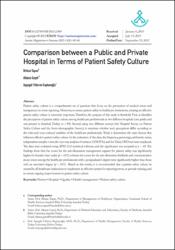| dc.contributor.author | Tapan, Birkan | |
| dc.contributor.author | Gayef, Albena | |
| dc.contributor.author | Kaptanoğlu, Ayşegül Yıldırım | |
| dc.date.accessioned | 2015-11-19T13:13:11Z | |
| dc.date.available | 2015-11-19T13:13:11Z | |
| dc.date.issued | 2015 | |
| dc.identifier.citation | Tapan B, Gayef A, Kaptanoglu AY. Comparison between a public and private hospital in terms of patient safety culture. Sanitas Magisterium.2015;1 (1-2): 45-60. doi: 10.12738/SM/2015.2.009 | en_US |
| dc.identifier.uri | http://sanitasmagisterium.com/issues/issue-1-2/ | en_US |
| dc.identifier.uri | https://hdl.handle.net/11446/831 | en_US |
| dc.description | İstanbul Bilim Üniversitesi, Tıp Fakültesi. | en_US |
| dc.description | İstanbul Bilim Üniversitesi, Sağlık Hizmetleri Meslek Yüksekokulu. | en_US |
| dc.description.abstract | Patient safety culture is a comprehensive set of practices that focus on the prevention of medical errors and transparency in event reporting. Moreover, to ensure patient safety in healthcare institutions, creating an effective patient safety culture is extremely important. Therefore, the purpose of this study is threefold. First, it identifies the perceptions of patient safety culture among healthcare professionals at two different hospitals (one public and one private) in Istanbul, Turkey (n = 80). Second, using two different surveys (the Hospital Survey on Patient Safety Culture and the Socio-demographic Survey), it examines whether such perceptions differ according to the roles and socio-cultural variables of the healthcare professionals. Third, it determines the main factors that influence effective patient safety culture. In the evaluation of the data, the frequency, percentage, arithmetic mean, independent samples t-test, the one-way analysis of variance (ANOVA), and the Tukey HSD test were employed. The data were evaluated using SPSS 21.0 statistical software, and the significance was accepted as p < .05. The findings show that the scores for the sub-dimension management support for patient safety was significantly higher for females than males (p = .017), whereas the scores for the sub-dimension feedback and communication about errors among the healthcare professionals with a postgraduate’s degree were significantly higher than those with an associate’s degree (p = .011). Based on the results, it is recommended that a patient safety culture be created by all healthcare institutions to implement an effective system for reporting errors, to provide training, and to ensure ongoing improvements in patient safety culture. | en_US |
| dc.language.iso | eng | en_US |
| dc.publisher | EDAM (Eğitim Danışmanlığı ve Araştırmaları Merkezi) | en_US |
| dc.identifier.doi | 10.12738/SM/2015.2.009 | en_US |
| dc.rights | info:eu-repo/semantics/openAccess | en_US |
| dc.subject | patient | en_US |
| dc.subject | hospital | en_US |
| dc.subject | quality | en_US |
| dc.subject | health management | en_US |
| dc.subject | patient safety culture | en_US |
| dc.title | Comparison between a public and private hospital in terms of patient safety culture | en_US |
| dc.type | article | en_US |
| dc.relation.journal | Sanitas Magisterium | en_US |
| dc.department | DBÜ, Sağlık Hizmetleri Meslek Yüksekokulu | en_US |
| dc.identifier.issue | 1-2 | |
| dc.identifier.volume | 1 | |
| dc.identifier.startpage | 45 | |
| dc.identifier.endpage | 60 | |
| dc.contributor.authorID | TR23247 | en_US |
| dc.contributor.authorID | TR36272 | en_US |
| dc.contributor.authorID | TR11987 | en_US |
| dc.relation.publicationcategory | Belirsiz | en_US |


















